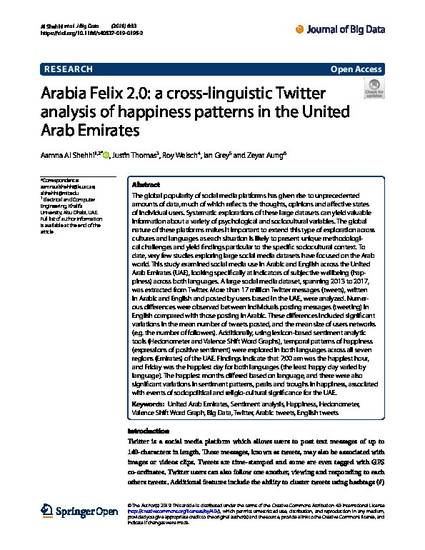
© 2019, The Author(s). The global popularity of social media platforms has given rise to unprecedented amounts of data, much of which reflects the thoughts, opinions and affective states of individual users. Systematic explorations of these large datasets can yield valuable information about a variety of psychological and sociocultural variables. The global nature of these platforms makes it important to extend this type of exploration across cultures and languages as each situation is likely to present unique methodological challenges and yield findings particular to the specific sociocultural context. To date, very few studies exploring large social media datasets have focused on the Arab world. This study examined social media use in Arabic and English across the United Arab Emirates (UAE), looking specifically at indicators of subjective wellbeing (happiness) across both languages. A large social media dataset, spanning 2013 to 2017, was extracted from Twitter. More than 17 million Twitter messages (tweets), written in Arabic and English and posted by users based in the UAE, were analyzed. Numerous differences were observed between individuals posting messages (tweeting) in English compared with those posting in Arabic. These differences included significant variations in the mean number of tweets posted, and the mean size of users networks (e.g. the number of followers). Additionally, using lexicon-based sentiment analytic tools (Hedonometer and Valence Shift Word Graphs), temporal patterns of happiness (expressions of positive sentiment) were explored in both languages across all seven regions (Emirates) of the UAE. Findings indicate that 7:00 am was the happiest hour, and Friday was the happiest day for both languages (the least happy day varied by language). The happiest months differed based on language, and there were also significant variations in sentiment patterns, peaks and troughs in happiness, associated with events of sociopolitical and religio-cultural significance for the UAE.
- Arabic tweets,
- Big Data,
- English tweets,
- Happiness,
- Hedonometer,
- Sentiment analysis,
- Twitter,
- United Arab Emirates,
- Valence Shift Word Graph
Available at: http://works.bepress.com/justin-thomas28211/12/